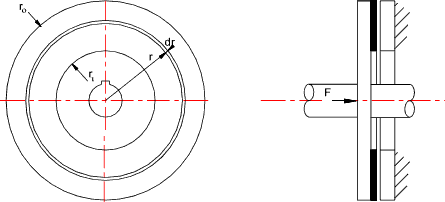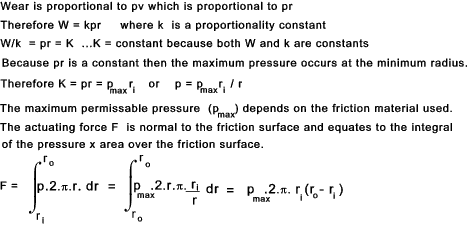Clutches
Disk Clutches, Axial or Plate Clutch
|
Introduction The Disk Clutch is used to transmit torque from an input to an output shaft
via circular plates (disks). One of each pair of plates is coated
with a friction lining material. The force applied to the friction element
may be manual, electrical, pneumatic, hydraulic or inertial via a mechanical linkage.
As the input and output shafts are fixed the clutch should include a method of
allowing the driving plates to move axially against the driven plates which are fixed
to the driven shaft (or vice versa). A selection of disk clutch plate materials with their important properties are provided on
page Brake/Clutch materials
Theory There are two operating conditions applicable to clutch plates
The wear (W)at any location on a cluthch is assumed to be proportional to the pressure intensity (p)and the associated relative velocity (v)of the local ring of contact.
The torque capacity of a clutch plate is the integral of the friction force (μ F) x Radius (r) Uniform pressure When considering the capacity of a disk clutch plate subject uniform pressure, every
point on the clutch plate face is subject to the the maximum design pressure for the friction
material. This condition applies mainly to new clutch plates
The torque capacity of a clutch plate is the integral of the friction force (μ F) x Radius (r) The above theory relates to single plate clutches. For multiple plates
in contact the torque values should be multiplied by the number of contacting plates |
Links to clutch Design
|
|
Clutches
Please Send Comments to Roy Beardmore




